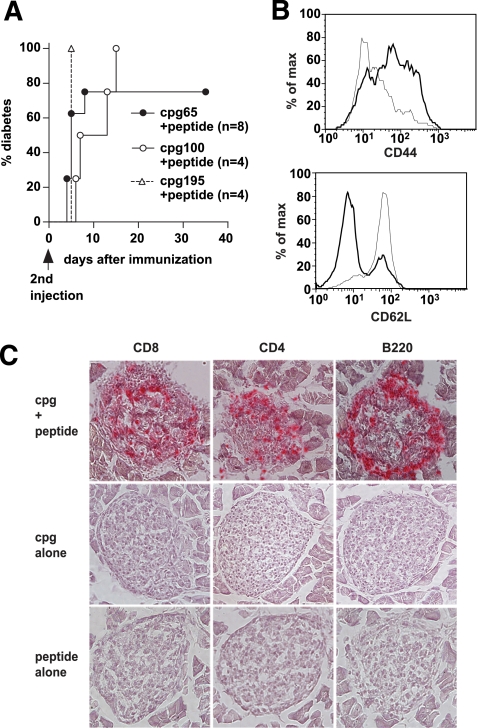FIG. 5.
Activated CD8 T-cells from G9Cα−/−.NOD mice cause diabetes. A: G9Cα−/−.NOD mice were immunized with B15-23 peptide (50 μg) together with CpG oligonucleotides at different doses (two injections, 9–21 days apart). Diabetes was seen after the second injection in the majority of mice and the graph illustrates the mice, following the second injection, immunized with peptide plus 65 μg CpG (●), peptide plus 100 μg CpG (○), and peptide plus 195 μg CpG (▵). Two of four mice immunized with peptide, and high-dose CpG (195 μg) actually developed diabetes before the second injection and the remaining two mice are shown in the graph. None of the control mice injected with peptide alone (n = 11) or the various doses of CpG alone (n = 13) developed diabetes (data not shown). P < 0.0001 when all groups were compared. B: Flow cytometry of spleen cells from a nonimmunized G9Cα−/−.NOD mouse, gated on CD8 T-cells, shown in the thin line, compared with cells from a diabetic mouse after CpG and peptide immunization, shown in the thick line. The upper panel shows upregulation of CD44 and the lower panel illustrates downregulation of CD62L. C: Histology showing sections from diabetic G9Cα−/−.NOD mouse immunized with CpG and peptide (top row), CpG alone (middle row), and peptide alone (bottom row), stained with anti-CD8, anti-CD4, and anti-B220 (B-cells). (A high-quality representation of this figure is available in the online issue.)

